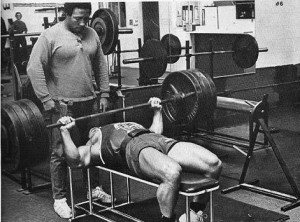Dungeon dwellers, for those who don’t know, are people who choose to train at home. Whether it’s in your basement, garage or wherever, the point is that you choose to do your training at home instead of in a gym. I myself have joined the legions of dungeon dwellers and, while I enjoy the solitude, have learned that there are unique challenges to training at home with limited equipment. Never to fear – a little ingenuity and dedication can overcome those issues easily.
Obviously if you’re going to train at home you need some kind of baseline equipment. I’m not talking about limiting your training to pushups and situps. If you’re going to get some serious training in you need to get serious equipment. A power rack with safeties is a must, as well as a good barbell and sufficient weight plates. Dumbbells are a great addition but if money is an issue they aren’t an absolute must. You should consider adding them eventually, however.
*A note on dumbbells: I looked around a lot to find good dumbbells for my home. I wanted something cost effective, space effective and durable. I weighed the options between adjustable DBs and actually buying a pair of Hex DBs in 10lb increments from 20-80lbs. In the end I ended up going with a heavy duty adjustable set by Iron Master and they’ve been fantastic. I don’t make money off recommending them but they are great. Heavy duty, good warranty, easily adjustable and I don’t have to worry about them snapping if I drop them. End note.
On top of those necessities you absolutely need a good adjustable bench and something to do pull-ups from if you want to have productive workouts. After you have those anything else is just for fun.
 Not pictured: A shiny cable crossover machine
Not pictured: A shiny cable crossover machine
Dungeon Workouts
One of the most difficult aspects of training at home can be feeling limited by the equipment you have available. I was never a “flavor of the month” lifter and have avoided excessive machine use like an Ebola patient for years. Even still, when I first started training at home I felt like I was restricted to only a handful of basic movements. Don’t get me wrong – those basic movements have always been the foundation of my training, and I have gone through extensive periods where they were all I performed. Still, I wanted to feel like I had the option to change up my training when necessary. The good thing is that with a barbell and even just one set of dumbbells I had tons of options. Here’s just a short list of movements and variations that I start incorporating:
Lower Body
Back & Front Squats
Romanian Deadlifts (And one legged variations)
Good Mornings
Paused Squats/Anderson Squats
Lunge variations (Front lunges, reverse lunges, Barbell and dumbbell variants)
Deadlifts
Cleans/Clean Pulls
Bulgarian Split Squats
Chest
All bench press variations (Flat, incline, decline, Paused bench, close grip)
Floor press
Dumbbell bench variations (Flat, incline, decline, One and two arm version)
DB Flyes
Pushups (Duh)
Reverse grip bench (Quickly becoming a favorite of mine)
Back
Pull-up variations (Pull-ups, chin-ups, mixed grip, weighted)
Barbell Rows (Under and overhand)
DB Row variations (1 Arm DB row, Paused rows, Chest supported rows, Unsupported)
Shrugs (DB, Barbell, 1 Armed)
Shoulders
Military Press
Behind the Neck Press
Push Press
Dumbbell Presses
Dumbbell Raises (Front raise, Lateral, Rear Delt Raise, Plate Front Raise)
Upright rows
Arms
Various curls (DB Curl, Barbell Curl, Hammer, Preacher, Scott Curls, etc)
Overhead DB Triceps Extensions
Skull Crushers (Barbell and Dumbbell)
JM Press
Abs/Core
Ab Wheel (Great addition to equipment)
Sit-up variations (Decline, flat, weighted)
Leg raises
Plank variations
Obviously there are more options but the list is already long enough as is. The point is that there are enough movements you can do with just a bar and some dumbbells to keep you happy for a long time. You just have to be a little creative. I’m not one for making up movements just for the sake of variety, so I avoid shit that doesn’t get the job done as much as possible. Even with that in mind I have found that I have enough options without ever needing to use a machine.
Here’s a look at a typical training week for me:
Day 1 – Legs
A1. Squats
A2. Pull-ups
B1. Romanian Deadlifts
B2. Sit-ups
C1. Bulgarian Split Squats
C2. Ab Wheel
Day 2 – Chest
A1. Bench Press
A2. Pull-ups
B1. Incline DB Press
B2. Grip work
C1. Reverse grip Bench
C2. DB Flye
Day 3 – Back
A1. Clean Pulls
A2. Weighted Pull-ups
B1. Deadlifts
B2. Neck work
C1. Barbell Rows
C2. Ab Wheel
Day 4 – Shoulders and Arms
A1. Press
A2. Chin-ups
B1. Close grip Bench
B2. Upright Row
C. 3 Way Shoulder circuit (Front raise, Lateral Raise, Rear Delt Raise)
D1. DB Preacher Curl on bench
D2. Skull Crusher
As you can see I like to do a lot of pull-ups. Aside from that I get pretty good workouts done with minimal equipment. In fact I’ve gotten spoiled and have no interest in ever stepping foot into a gym again. My training is straight to the point, no bullshit, nobody bothers me (except occasionally my dogs or cats) and my commute time to the gym is about 8 seconds.
Training at home might not be for everybody but it’s been working great for me. I like the solitude and it lets me focus solely on my lifting. Even if you do train in a gym the point is that you can do a lot with minimal equipment. Of course change is good and jumping on a machine every once in a while isn’t going to hurt. For example, I wish I had something to do leg curls/extensions on. Until I then, I’ll just stick to squats.